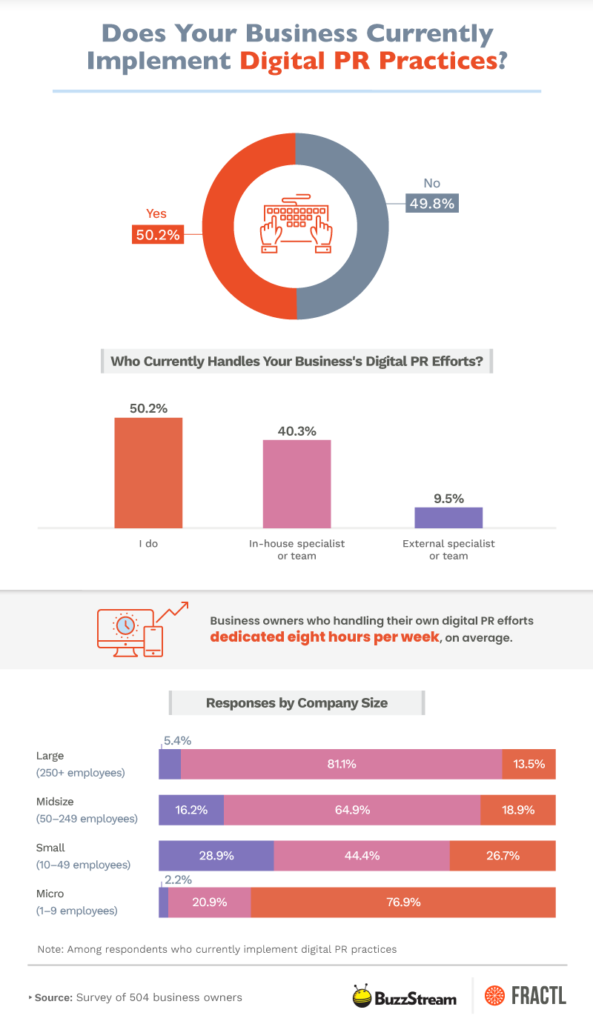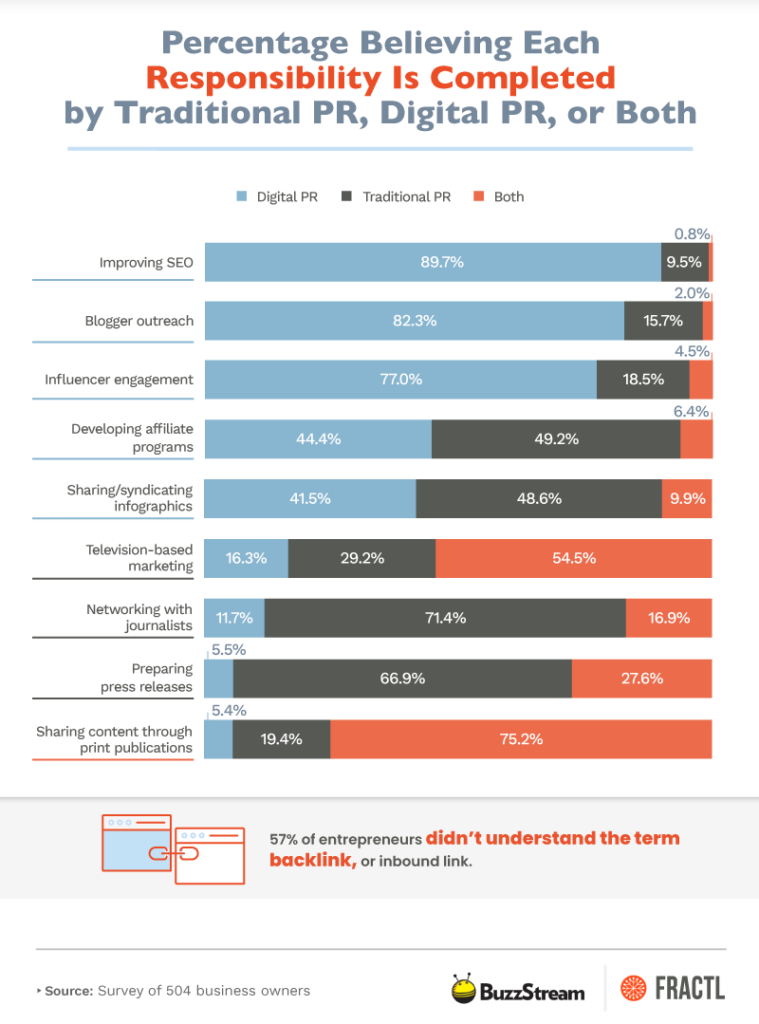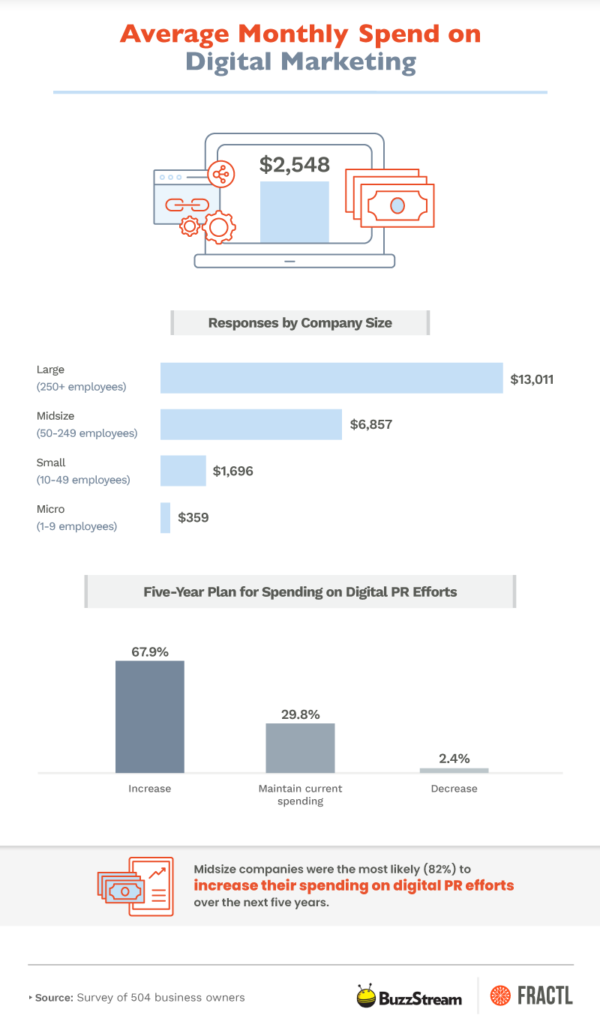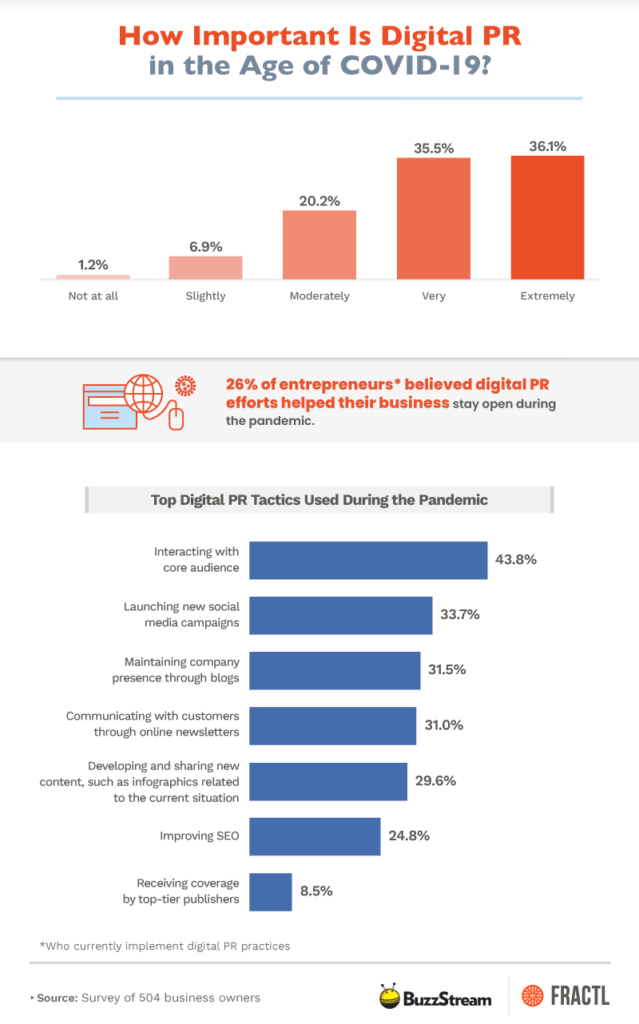Key Takeaways
- 50% of surveyed entrepreneurs implemented digital PR practices in their business.
- Over half of entrepreneurs reported handling their business’s digital PR efforts.
- 57% of entrepreneurs didn’t understand the terms backlink or inbound link.
- 68% of entrepreneurs planned to increase spending on digital PR over the next five years.
- 72% of entrepreneurs believed digital PR is very to extremely important in the age of COVID-19.
A better online presence, especially now while people are spending more time using the internet, could bring new clients to businesses and help to engage existing customers. But do business owners know the importance of digital PR, and are they maintaining sufficient budgets for an in-house or external team?
BuzzStream and Fractl surveyed 504 business owners to understand their perceptions of digital PR. Our findings indicate what percentage of businesses use digital PR, whether owners appreciate its importance, how much money is allocated for a team, and how companies have changed their strategies to account for the COVID-19 pandemic. Read on for our research takeaways.
Implementing Digital PR
The majority of business owners surveyed (70%) agreed that digital PR is valuable when running a business. However, further analysis showed only 50% of owners implement digital PR practices.
Although half of the business owners surveyed implemented digital PR in some way, only 49.8% of those had a dedicated team. A slight majority of owners reported personally handling digital efforts but confessed to only devoting about eight hours per week, on average – barely scratching the surface. Micro-companies consisting of one to nine employees were more likely to have an owner-operated digital PR effort, while larger businesses tended to opt for an in-house team.
According to business owners, one of the top benefits of having a designated digital PR team was that it frees up their personal time (72.7%), allowing them to handle different aspects of the company. Other advantages had to do with the nature of digital PR: A team helps companies to stay relevant (58.4%), ensures that your core audience sees a consistent presence (58.1%), and helps the business remain competitive (56%). But because digital PR is not about maintaining a Rolodex of journalist contacts, owners reported that relying on professional digital PR specialists helped them produce sophisticated backlinks (43%), increase their ROI (42.4%), obtain more accurate reporting (36.3%), and build rapport with publishers (31.6%).
Do Entrepreneurs Understand Digital PR?
As mentioned above, about 50% of business owners handled their own digital PR. To determine whether they understand how digital PR differs from traditional PR, we quizzed them.
Our questions uncovered that the majority of business owners conflate digital PR and traditional PR. We found that a slight majority (57%) aren’t familiar with the term backlinking, or when one website links to another. Along with improving search engine optimization (SEO) and increasing social media mentions, gaining high-quality backlinks is one of the benefits of an effective digital PR practice.
Roughly 9 in 10 business owners were aware that digital PR is responsible for helping improve SEO. Eighty-two percent knew that digital PR drives blogger outreach, and 77% understood that it’s accountable for influencer engagement. But the waters became murky when business owners were asked to determine if traditional PR or digital PR is responsible for developing affiliate programs and sharing and syndicating infographics.
How Much Money Do Entrepreneurs Allocate to Digital Marketing?
Business owners spent an average of $2,548 monthly on digital PR. But micro-companies, with one to nine employees, reported spending much less ($359 per month). Large companies, with 250 or more employees, typically spent an average of $13,011 per month. Roughly 68% of business owners said they plan to increase their digital PR spending over the next five years.
- On average, respondents allocated 15% of their overall budget to digital marketing.
- Business owners estimated that an average 27% of their business’s earnings resulted from digital marketing efforts.
Digital PR in the Age of COVID-19
Businesses need to communicate any COVID-19-related changes that may have occurred to their customers. Perhaps that’s why over 1 in 4 owners increased their digital PR spending during the pandemic, and 71.6% of business owners found digital PR very or extremely important in the age of COVID-19. Twenty-six percent of business owners went on to say that digital PR efforts helped their business stay open during the pandemic.
According to our findings, the top digital tactics practitioners used during the COVID-19 pandemic were interacting with a business’s core audience (43.8%), launching new social media campaigns (33.7%), and maintaining company presence through blogs (31.5%). Other tactics helped businesses reach customers or bring in new ones through SEO improvement (24.8%) and top-tier publisher coverage (8.5%).
- Large-sized businesses were the most likely to believe that digital PR efforts helped them stay open during the pandemic.
- 15% of business owners believed digital marketing helped support their business to a great extent during the COVID-19 pandemic.
- 25% of business owners expected to cut funds allocated to digital marketing during the pandemic, but only 12% of business owners would cut digital marketing first.
Entrepreneurs Find Digital PR Essential, Especially During the COVID-19 Pandemic
Millions of business owners have had to cut expenses to survive the COVID-19 pandemic, which is one reason 23.1 million Americans are unemployed. But the majority of business owners know the importance of digital PR, and, as a result, one-quarter of them have increased their digital PR spending during the pandemic. Communicating with your audience and attracting new business during a crisis is possible, a team just needs the right digital PR specialists.
Methodology and Limitations
We surveyed 504 entrepreneurs in the U.S. about their perceptions and implementation of digital PR. To help ensure respondents were paying attention and taking our survey seriously, an attention-check question was employed to identify and disqualify those who failed to fully read questions. The main limitation of this survey is these data rely on self-reporting. Potential issues with self-reported data include, but are not limited to, exaggeration, selective memory, and attribution errors on the part of respondents.
Fair Use Statement
The pressure to downsize your budget during the COVID-19 pandemic is understandable, but digital PR is critical during this time. We encourage you to read and share our survey findings about how business owners perceive digital PR for noncommercial reuse. All we ask is that you link back here, so readers may view the project in full and review the methodology and limitations.

 End-to-end outreach workflow
End-to-end outreach workflow









 Check out the BuzzStream Podcast
Check out the BuzzStream Podcast







